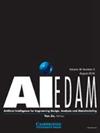使用深度学习实现对灵感设计刺激的多模式搜索
IF 2.3
3区 工程技术
Q3 COMPUTER SCIENCE, ARTIFICIAL INTELLIGENCE
Ai Edam-Artificial Intelligence for Engineering Design Analysis and Manufacturing
Pub Date : 2022-07-27
DOI:10.1017/S0890060422000130
引用次数: 7
摘要
摘要众所周知,在早期设计过程中,启发性刺激可以有效地支持构思。然而,先前的工作主要限制设计师在搜索刺激时使用纯文本查询,这与现实世界的设计行为不一致,在现实世界中,跨模态(例如,视觉、语义等)的流动性是标准做法。在当前的工作中,我们介绍了一个多模式搜索平台,该平台使用基于文本、外观和功能的搜索输入,以3D模型部件的形式检索鼓舞人心的刺激。提出了利用深度学习方法设计和支持该平台的计算方法,该平台依赖于在3D模型零件的大型数据集上训练的深度神经网络。这项工作进一步展示了一项认知研究的结果(n=21),其中上述搜索平台被用来寻找零件,以启发设计挑战的解决方案。参与者采用三种不同的搜索模式:按关键字、3D零件和用户在工作空间中组装的3D零件。当按选定的部分或在其工作空间中进行搜索时,参与者对结果相对于输入的外观和功能的相似性有额外的控制权。这项研究的结果表明,所使用的模式会影响搜索行为,例如搜索频率、检索到的搜索结果的使用方式以及搜索空间的覆盖范围。特定结果将与界面的交互链接到参与者在任务期间可能使用的搜索策略。研究结果表明,在搜索鼓舞人心的刺激时,既可以通过直接搜索输入(例如,通过关键字),也可以通过更随机地发现的示例(其中没有定义特定目标)来获得期望的结果。研究发现,在设计用于激励刺激检索的搜索平台时,这两个搜索过程都很重要。本文章由计算机程序翻译,如有差异,请以英文原文为准。
Enabling multi-modal search for inspirational design stimuli using deep learning
Abstract Inspirational stimuli are known to be effective in supporting ideation during early-stage design. However, prior work has predominantly constrained designers to using text-only queries when searching for stimuli, which is not consistent with real-world design behavior where fluidity across modalities (e.g., visual, semantic, etc.) is standard practice. In the current work, we introduce a multi-modal search platform that retrieves inspirational stimuli in the form of 3D-model parts using text, appearance, and function-based search inputs. Computational methods leveraging a deep-learning approach are presented for designing and supporting this platform, which relies on deep-neural networks trained on a large dataset of 3D-model parts. This work further presents the results of a cognitive study (n = 21) where the aforementioned search platform was used to find parts to inspire solutions to a design challenge. Participants engaged with three different search modalities: by keywords, 3D parts, and user-assembled 3D parts in their workspace. When searching by parts that are selected or in their workspace, participants had additional control over the similarity of appearance and function of results relative to the input. The results of this study demonstrate that the modality used impacts search behavior, such as in search frequency, how retrieved search results are engaged with, and how broadly the search space is covered. Specific results link interactions with the interface to search strategies participants may have used during the task. Findings suggest that when searching for inspirational stimuli, desired results can be achieved both by direct search inputs (e.g., by keyword) as well as by more randomly discovered examples, where a specific goal was not defined. Both search processes are found to be important to enable when designing search platforms for inspirational stimuli retrieval.
求助全文
通过发布文献求助,成功后即可免费获取论文全文。
去求助
来源期刊
CiteScore
4.40
自引率
14.30%
发文量
27
审稿时长
>12 weeks
期刊介绍:
The journal publishes original articles about significant AI theory and applications based on the most up-to-date research in all branches and phases of engineering. Suitable topics include: analysis and evaluation; selection; configuration and design; manufacturing and assembly; and concurrent engineering. Specifically, the journal is interested in the use of AI in planning, design, analysis, simulation, qualitative reasoning, spatial reasoning and graphics, manufacturing, assembly, process planning, scheduling, numerical analysis, optimization, distributed systems, multi-agent applications, cooperation, cognitive modeling, learning and creativity. AI EDAM is also interested in original, major applications of state-of-the-art knowledge-based techniques to important engineering problems.

 求助内容:
求助内容: 应助结果提醒方式:
应助结果提醒方式:


